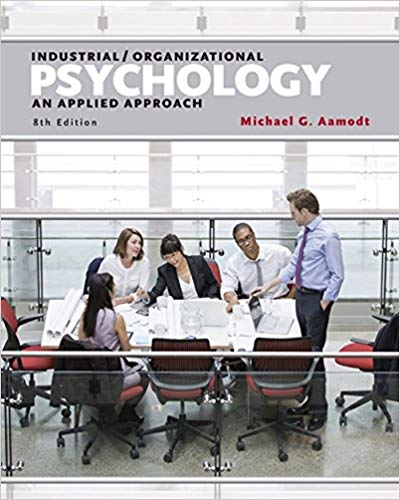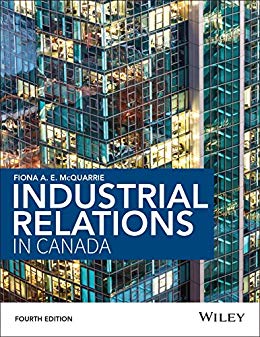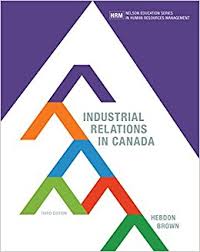Description
Test Bank For Industrial Organizational Psychology An Applied Approach 8th Edition by Michael G. Aamodt
|
Multiple Choice |
|
1. I/O Psychology is a branch of psychology that _____ in the workplace. a. treats psychological disorders b. applies the principles of psychology c. provides therapy to employees d. all of these equally define I/O psychology ANSWER: b |
|
2. I/O psychology examines factors that affect the _______ in an organization, whereas business fields examine the broader aspects of running an organization. a. people b. machines c. stock performance d. I/O psychology examines all three factors ANSWER: a |
|
3. I/O psychologists who are involved in ________ study and practice in such areas as employee selection, job analysis, and job evaluation. a. personnel psychology b. organizational psychology c. training and development d. human factors ANSWER: a |
|
4. The study of leadership is part of: a. personnel psychology b. training and development c. human factors d. organizational psychology ANSWER: d |
|
5. Psychologists involved in _______ study leadership, job satisfaction, and employee motivation. a. personnel psychology b. organizational psychology c. training and development d. human factors ANSWER: b |
|
6. Regardless of the official start date, I/O psychology was born in the: a. mid 1800s b. late 1800s c. early 1900s d. mid 1900s ANSWER: c |
|
7. I/O Psychology first started about: a. 1840 b. 1938 c. 1903 d. 1957 ANSWER: c |
|
8. The _____ were a husband and wife team who were among the first scientists to improve productivity and reduce fatigue by studying the motions used by workers. a. Watsons b. Scotts c. Binghams d. Gilbreths ANSWER: d |
|
9. In which decade were the Hawthorne studies published. a. 1920s b. 1930s c. 1960s d. 1980s ANSWER: b |
|
10. Changes in employee behavior that result from an employee being studied or receiving increased attention from mangers is called the: a. Hawthorne effect b. Premack principle c. Pygmalion effect d. Peter principle ANSWER: a |
|
11. The ____ were characterized by passage of several major pieces of civil rights legislation. a. 1930s b. 1960s c. 1970s d. 1980s ANSWER: b |
|
12. The use of more sophisticated statistical techniques, a more aggressive approach in developing methods to select employees, and an increased interest in the application of cognitive psychology to industry took place in the: a. 1920s and 30s b. 1940s and 50s c. 1960s and 70s d. 1980s and 90s ANSWER: d |
|
13. The greatest number of Ph.D. I/O psychologists work in: a. universities b. consulting firms c. private industry d. the public sector ANSWER: a |
|
14. Compared to Ph.D.’s, master’s level graduates are less often employed by: a. universities b. consulting firms c. the private industry d. the public sector ANSWER: a |
|
15. To get accepted into a graduate program in I/O psychology, a student usually must take which of the following standardized tests? a. LSAT b. MCAT c. SAT d. GRE ANSWER: d |
|
16. Which of the following would a student in a doctoral program usually have to complete but a student in a master’s program would not? a. Thesis b. Dissertation c. Internship d. A statistics course ANSWER: b |
|
17. According to your text, the most important reason for the reliance on research is that it ultimately: a. reduces accidents b. saves an organization money c. increases employee satisfaction d. reduces turnover ANSWER: b |
|
18. Which of the following was NOT a reason why you should understand research and statistics? a. answering questions b. research is part of everyday life c. common sense is often wrong d. all of these are reasons ANSWER: d |
|
19. Hypotheses are based on: a. previous research b. logic c. theories d. all three of these ANSWER: d |
|
20. Which of the following is the reason for WHY a study obtains certain results? a. Hypothesis b. Idea c. Postulation d. Theory ANSWER: d |
|
21. If researchers have trouble forming a hypothesis, they: a. can’t conduct their study b. wait until more research is available c. conduct an exploratory study d. guess about the outcome of a study ANSWER: c |
|
22. Conducting a literature review means: a. reading the classics b. seeing if similar research has been conducted c. assessing a study’s reading level d. calling other researchers for their opinion ANSWER: b |
|
23. Which of the following is a leading journal in I/O psychology? a. Journal of Applied Psychology b. Research in the Study of Work c. I/O Psychology review d. None of these is the leading journal ANSWER: a |
|
24. The Harvard Business Review is an example of a: a. journal b. trade magazine c. magazine d. bridge publication ANSWER: d |
|
25. Which of the following contain articles usually written by professional writers who have little expertise in a given field? a. Journals b. Magazines and journals c. Magazines d. None of these is correct ANSWER: c |
|
26. What field research gains in _______ it loses in _______. a. control / external validity b. power / control c. internal validity / power d. external validity / control ANSWER: d |
|
27. To ensure that subjects are participating in a study of their own free will, researchers must obtain : a. permission from the APA b. a writ of mandamus from the participant c. informed consent from the participant d. a valid control group ANSWER: c |
|
28. To ensure ethical treatment of subjects, universities have: a. institutional review boards b. the APA closely monitor every study c. witnesses during experiments d. All of these are true ANSWER: a |
|
29. The most powerful research method is the: a. correlational method b. quasi-experimental method c. archival method d. experimental method ANSWER: d |
|
30. Which of the following research methods can determine a cause and effect relationship? a. Correlational method b. Quasi-experimental method c. Archival method d. Experimental method ANSWER: d |
|
31. The variable that is manipulated in an experiment is the ________ variable. a. independent b. dependent c. intervening d. control ANSWER: a |
|
32. The variable that we expect to change as a result of our manipulation is called the: a. independent variable b. dependent variable c. intervening variable d. control variable ANSWER: b |
|
33. Manipulating the _____ best distinguishes experimental research methods from other research methods. a. dependent variable b. intervening variable c. statistical results d. independent variable ANSWER: d |
|
34. In an experiment designed to test the effect of noise on employee performance, noise is the ______ and employee performance is the ______. a. dependent variable/independent variable b. dependent variable / control variable c. independent variable/dependent variable d. control variable / dependent variable ANSWER: c |
|
35. Researchers at IBM think that employees who get to chose their own working hours will be more satisfied than those who do not. To test this idea, IBM employees at the Dallas facility are told that they can chose their own hours. Six months later, the satisfaction level of employees in the Dallas facility is compared to employees in the Knoxville facility. The employees in the Knoxville facility are considered the: a. dependent variable b. control group c. experimental group d. independent variable ANSWER: b |
|
36. The main difference between a quasi-experiment and an experiment is that the independent variable: a. is manipulated in an experiment b. is manipulated in a quasi-experiment c. has 3 levels in an experiment d. cannot be measured in a quasi-experiment ANSWER: a |
|
37. Even though they lack control, ____ are used due to ____ reasons. a. experiments / ethical b. correlational designs / historical c. archival methods / statistical d. quasi-experiments/ethical & practical ANSWER: d |
|
38. _____ research sacrifices external validity for control of extraneous variables whereas _____ research sacrifices the control of extraneous variables for external validity. a. Laboratory / field b. Field / laboratory c. Archival / quasi-experimental d. Quasi-experimental /archival ANSWER: a |
|
39. Which of the following research methods uses previously collected company records? a. Experimental b. Survey c. Archival d. Meta-analysis ANSWER: c |
|
40. If I went through my employee files to determine what type of person makes the best employee, I would probably be conducting: a. archival research b. a meta-analysis c. a field study d. an experiment ANSWER: a |
|
41. Which of the following survey methods has the lowest response rate? a. Interview b. Email c. Mail d. The three have equal response rates ANSWER: b |
|
42. you used an email survey, your results would be representative of the population in terms of: a. sex b. race c. both sex and race d. neither sex nor race ANSWER: a |
|
43. Which of the following will increase the response rates to mailed surveys? a. Include a monetary incentive b. Keep the survey under 4 pages c. Have a university sponsor the survey d. All will increase response rates ANSWER: d |
|
44. A researcher sent a survey containing 5 questions to a sample of 500 employees. The wording was easy to understand and the researcher offered a financial incentive yet few employees returned the survey. What might be the reason for this low response? a. The number of questions b. The use of a financial incentive c. The easy-to-understand wording d. None of the three is a reasonable explanation ANSWER: d |
|
45. _______ is a method of reaching conclusions based on the statistical combination of several previous research studies. a. The experimental method b. Quasi-experimental analysis c. Archival research d. Meta-analysis ANSWER: d |
|
46. In a meta-analysis conducted to see if a particular training method is better than another, the proper effect size to use would be: a. d b. r c. Z d. t ANSWER: a |
|
47. Meta-analyses looking at the difference between two groups would use ___ as the effect size whereas meta-analyses looking at the relationship between two variables would use ___ as the effect size. a. d / r b. r / d c. t / d d. t / F ANSWER: a |
|
48. An effect size (d) of .20 is considered: a. small b. large c. moderate d. significant ANSWER: a |
|
49. The statistical “averaging” of effect sizes across previous empirical studies defines: a. experimental research b. meta-analysis c. correlational research d. archival research ANSWER: b |
|
50. A large research sample is nice to have, however, it may not be necessary if the experimenter can choose a ______ sample and control for many of the ______ variables. a. random / extraneous b. extraneous / random c. representative / nuisance d. homogeneous / confounding ANSWER: a |
|
51. The majority of research in the field of I/O psychology is conducted at universities using students as subjects rather than employees. In fact, college students serve as subjects in approximately ____ percent of all published I/O research. a. 5% b. 50% c. 85% d. 99% ANSWER: b |
|
52. In general, the majority of the research comparing college student samples with actual employee samples conclude that college students behave _______ real world samples. a. similar to b. different than c. No research is available d. The research results are inconsistent ANSWER: d |
|
53. A _____ implies that each person in the population has an equal chance of being selected. a. random sample b. convenience sample c. random assignment d. convenience assignment ANSWER: a |
|
54. Most research in industry uses a ________ sample. a. random b. convenience sample c. free sample d. stratified sample ANSWER: b |
|
55. A teacher wants to see if there are any differences in the test scores of students who take her exam on the computer and those who take her exam the traditional paper and pencil way. Students with an odd digit at the end of their student ID number are required to take her midterm exam on the computer and those with an even digit are required to take a paper and pencil exam. Her study has a _____ sample with _____. a. random / random assignment b. convenience / random assignment c. convenience / nonrandom assignment d. random / nonrandom ANSWER: b |
|
56. After all the data have been collected, the results are then: a. filed for future use b. shared between colleagues c. statistically analyzed d. data collection never ends ANSWER: c |
|
57. The level of statistical significance that we use in psychology is: a. .01 b. .05 c. .10 d. .50 ANSWER: b |
|
58. The statistical significance of research results tell us the probability that: a. our results were due to chance b. our results are useful c. our results are biased d. all of these are true ANSWER: a |
|
59. Significance levels tell us the ______ significance of a study and effect size tells us the _______ of a study. a. statistical / alpha level b. practical / beta level c. practical / statistical significance d. statistical / practical significance ANSWER: d |
|
60. Which of the following represents the strongest correlation? a. - .05 b. +.45 c. +.10 d. - .47 ANSWER: d |
|
61. If a researcher calculated a correlation coefficient of r = 1.27 between two variables, you would conclude that there is a(n): a. high correlation b. very low correlation c. error in the calculation d. moderately low positive correlation ANSWER: c |
|
62. The use of correlational analysis does not allow you to infer a cause and effect relationship. This is because a third variable, a(n) ______ variable, often accounts for the relationship between the two variables. a. intervening b. nuisance c. confounding d. dependent ANSWER: a |
|
63. A researcher finds a strong correlation between job satisfaction and performance. What can he conclude from this correlation? a. Satisfaction causes good performance b. Good performance causes job satisfaction c. Satisfaction and performance are related d. He can conclude all three ANSWER: c |
|
64. In a ______ ethical dilemma, there is a high level of uncertainty as to what is right or wrong. a. rationalizing b. Type A c. type B d. deconstructive ANSWER: b |
|
Objective Short Answer |
|
65. What are the three major fields of I/O psychology?
|
|
66. What are the three reasons your book listed for why you should be interested in research?
|
|
67. What are the three sampling methods listed in the text?
|
|
68. What are the differences between ideas, hypotheses, and theories?
|
|
69. What are important considerations when choosing a research sample?
|





Be the first to review “Test Bank For Industrial Organizational Psychology An Applied Approach 8th Edition by Michael G. Aamodt”